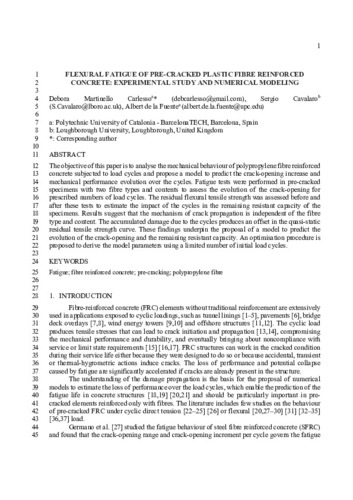Mostra el registre d'ítem simple
Flexural fatigue of pre-cracked plastic fibre reinforced concrete: experimental study and numerical modeling
| dc.contributor.author | Martinello Carlesso, Debora |
| dc.contributor.author | Pialarissi Cavalaro, Sergio Henrique |
| dc.contributor.author | Fuente Antequera, Albert de la |
| dc.contributor.other | Universitat Politècnica de Catalunya. Doctorat en Enginyeria de la Construcció |
| dc.contributor.other | Universitat Politècnica de Catalunya. Departament d'Enginyeria Civil i Ambiental |
| dc.date.accessioned | 2021-02-04T14:31:48Z |
| dc.date.available | 2022-10-21T00:27:28Z |
| dc.date.issued | 2021-01 |
| dc.identifier.citation | Martinello Carlesso, D.; Pialarissi, S.; De la Fuente, A. Flexural fatigue of pre-cracked plastic fibre reinforced concrete: experimental study and numerical modeling. "Cement and concrete composites", 2021, vol. 115, p. 103850:1-103850:11. |
| dc.identifier.issn | 0958-9465 |
| dc.identifier.uri | http://hdl.handle.net/2117/336922 |
| dc.description.abstract | The objective of this paper is to analyse the mechanical behaviour of polypropylene fibre reinforced concrete subjected to load cycles and propose a model to predict the crack-opening increase and mechanical performance evolution over the cycles. Fatigue tests were performed in pre-cracked specimens with two fibre types and contents to assess the evolution of the crack-opening for prescribed numbers of load cycles. The residual flexural tensile strength was assessed before and after these tests to estimate the impact of the cycles in the remaining resistant capacity of the specimens. Results suggest that the mechanism of crack propagation is independent of the fibre type and content. The accumulated damage due to the cycles produces an offset in the quasi-static residual tensile strength curve. These findings underpin the proposal of a model to predict the evolution of the crack-opening and the remaining resistant capacity. An optimisation procedure is proposed to derive the model parameters using a limited number of initial load cycles. |
| dc.description.sponsorship | The first author thanks the Brazilian National Council for Scientific and Technological Development for the scholarship granted (233980/2014-8). This research was enabled by funds provided by the SAES project (BIA2016-78742-C2-1-R) of Spanish Ministerio de Economía, Industria y Competitividad. Likewise, this work was only possible thanks to the support from the Laboratory of Technology of Structures and Materials “Lluis Agulló" of Polytechnic University of Catalonia. |
| dc.language.iso | eng |
| dc.publisher | Elsevier |
| dc.rights | © 2019. Elsevier |
| dc.rights | Attribution-NonCommercial-NoDerivatives 4.0 International |
| dc.rights.uri | https://creativecommons.org/licenses/by-nc-nd/4.0/ |
| dc.subject | Àrees temàtiques de la UPC::Enginyeria civil::Materials i estructures::Materials i estructures de formigó |
| dc.subject.lcsh | Reinforced concrete--Fatigue |
| dc.subject.other | Fatigue |
| dc.subject.other | Fibre reinforced concrete |
| dc.subject.other | Pre-cracking |
| dc.subject.other | Polypropylene fibre |
| dc.title | Flexural fatigue of pre-cracked plastic fibre reinforced concrete: experimental study and numerical modeling |
| dc.type | Article |
| dc.subject.lemac | Formigó armat -- Fatiga |
| dc.contributor.group | Universitat Politècnica de Catalunya. EC - Enginyeria de la Construcció |
| dc.identifier.doi | 10.1016/j.cemconcomp.2020.103850 |
| dc.description.peerreviewed | Peer Reviewed |
| dc.relation.publisherversion | https://www.sciencedirect.com/science/article/abs/pii/S0958946520303553 |
| dc.rights.access | Open Access |
| local.identifier.drac | 30466414 |
| dc.description.version | Postprint (author's final draft) |
| dc.relation.projectid | info:eu-repo/grantAgreement/MINECO/1PE/BIA2016-78742-C2-1-R |
| local.citation.author | Martinello Carlesso, D.; Pialarissi, S.; de la Fuente, A. |
| local.citation.publicationName | Cement and concrete composites |
| local.citation.volume | 115 |
| local.citation.startingPage | 103850:1 |
| local.citation.endingPage | 103850:11 |
Fitxers d'aquest items
Aquest ítem apareix a les col·leccions següents
-
Articles de revista [133]
-
Articles de revista [3.006]
-
Articles de revista [339]


